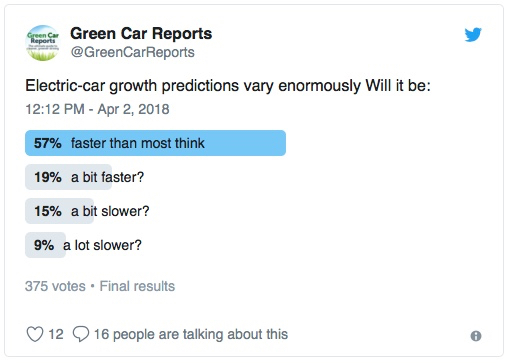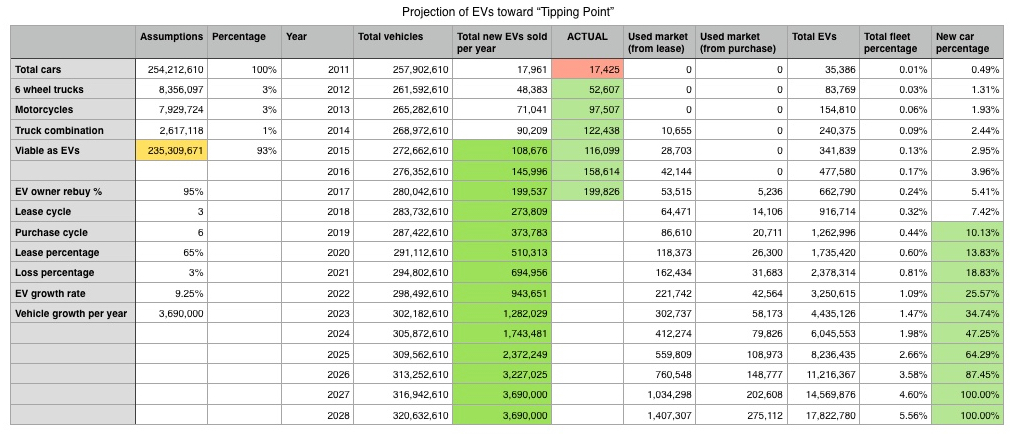Green Car Reports published the results of a reader poll, regarding readers’ predictions for EV adoption. EV owners, being an optimistic bunch, selected the answer, “faster than most people think” 57% of the time, with the remaining 43% split among “a bit faster,(19%)” “a bit slower (15%)” and “a lot slower. (9%)” I contend that those of us driving plug-in vehicles today are optimists, because we adopted a new technology, investing thousands of dollars of our hard-earned income, on basically, a bet. We bet there would be places to get our EVs serviced, infrastructure deployed, demand for our used vehicles, reliability in the battery packs, etc. We also bet we could change the world for the better, perhaps even save the planet, by showing others that we can drive cleaner, but still have fun. Some of us (me included) added solar panels to reduce our carbon footprint (and/or save money) and many have switched our electricity provider or plan, to one that uses renewable energy.
I contend that those of us driving plug-in vehicles today are optimists, because we adopted a new technology, investing thousands of dollars of our hard-earned income, on basically, a bet. We bet there would be places to get our EVs serviced, infrastructure deployed, demand for our used vehicles, reliability in the battery packs, etc. We also bet we could change the world for the better, perhaps even save the planet, by showing others that we can drive cleaner, but still have fun. Some of us (me included) added solar panels to reduce our carbon footprint (and/or save money) and many have switched our electricity provider or plan, to one that uses renewable energy.
I wrote about possible growth rates of EVs in January of 2015. Being a math guy, I had to create a spreadsheet (sound familiar yet?) and asked my coworkers how they thought EVs would fare. GCR’s poll reminded me of this old post and made me curious. I thought to myself: “I wonder which of the three paths EV adoption seems to be taking?”
As it turns out, my Goldilocks approach included three spreadsheets: worst case, middle case and best case. I was rooting for “best case,” obviously. I mean, my title IS EVangelist, after all…
Here’s how it has been going…(drum roll, please…the actual adoption of plug-in vehicles has done slightly better than the middle-of-the-road case! (click on image to open larger version) This spreadsheet has multiple inputs (commonly referred to as “guesses”) and the relationship to these inputs may not be correct, but the important thing is this: Actual sales exceeded the estimated sales for the years after the blog post was published! This is GREAT news! Since there are multiple inputs to the spreadsheet, I decided to play with the inputs, while keeping the results aligned with the sales results of the past three years.
This spreadsheet has multiple inputs (commonly referred to as “guesses”) and the relationship to these inputs may not be correct, but the important thing is this: Actual sales exceeded the estimated sales for the years after the blog post was published! This is GREAT news! Since there are multiple inputs to the spreadsheet, I decided to play with the inputs, while keeping the results aligned with the sales results of the past three years.
In my original middle-of-the-road spreadsheet, I set the percentage of plug-in vehicle owners who would purchase a plug-in again, instead of going back to an ICE vehicle, at 75%. In the original article, I thought this was way to low. I also set the growth in plug-in vehicle sales to be 12.5% annually and EV loss through accidents at 4%. I changed the “rebuy” at a much higher 95%, which is much more realistic, based on what I am seeing at the dealership. Making that change, made the 2017 prediction slightly lower than the actual sales number, so I looked at other inputs to change. Changing the “loss percentage” did not change the prediction results, so next, I turned to “EV growth rate.” I reduced the growth rate to 9.25% and the actual sales of 2017 again was higher than the prediction. That may seem like bad news, but it’s not. Based on these inputs, the spreadsheet predicts that new plug-in vehicle sales will exceed 10% of all new vehicle sales (vehicles that could actually be replaced with plug-ins, not 1 ton pickups, for instance) in 2019.
You read that right, 2019. Here’s how it looks, with the modifications: The percentage of total vehicles, bought each year, that can be replaced by EVs was set at 93%. That doesn’t account for styling preferences. For instance, there may be people that buy pickup trucks, just because they like driving pickup trucks, even though they rarely, if ever, carry cargo in the bed or tow a heavy trailer. The advent of plug-in pickups will alter that percentage, but since there are no plug-in pickups available today (with the possible exception of Via Motors), I’ll leave things at 93%.
The percentage of total vehicles, bought each year, that can be replaced by EVs was set at 93%. That doesn’t account for styling preferences. For instance, there may be people that buy pickup trucks, just because they like driving pickup trucks, even though they rarely, if ever, carry cargo in the bed or tow a heavy trailer. The advent of plug-in pickups will alter that percentage, but since there are no plug-in pickups available today (with the possible exception of Via Motors), I’ll leave things at 93%.
Things that could cause this to accelerate include: a substantial rise in gasoline prices, breakthroughs in charging/batteries, evidence and/or consequences of global climate change becoming apparent, better advertising by EV manufacturers, better educated consumers and the steady decrease in manufacturing costs.
One other thing that will help: the flood of new plug-in vehicles coming to market or announced. New form factors, like crossovers, SUVs and sports cars (affordable for the masses, please) could really heat things up. This is happening now!
All in all, I am excited by the results. I’ll start revisiting this spreadsheet annually, to see how things are going. To Green Car Reports: I think your readers are on to something! Thanks for the poll/reminder!


I just saw a great commercial for the Honda Clarity PHEV. You know, the kind of commercial where the automaker is actually trying to sell the car.
It’s the kind of commercial I have never seen for the Chevy Volt but always wanted to.
Is there a commercial out for the Bolt?
Maybe I was dreaming.